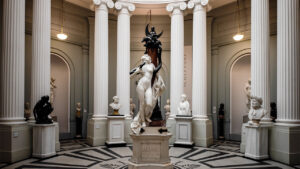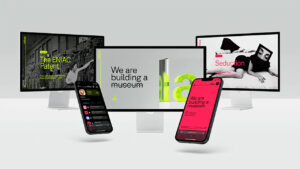With the emergence of NFTs in 2021, the potential for museums to build next-gen virtual experiences has intensified. The ability to provide digital goods coupled with the prospect of the metaverse has additionally opened the door for institutions to welcome new patrons and audiences.
On July 28, Jing Culture & Crypto and Iconic Moments co-presented the “Delivering the Museum Experience Through NFTs” webinar, featuring a panel of speakers — including independent writer and researcher Frances Liddell and Diane Drubay, Founder of We Are Museums and Head of Arts & Culture of TZ Connect at Tezos — who discussed the various aspects of incorporating blockchain technology into museum exhibitions and visitor experience. Here were some key talking points.
Creating experience through storytelling

Referencing her Crypto Connections research project at the National Museums Liverpool, Liddell highlighted the use NFTs in storytelling as a two-way street. Image: @NML_Muse on Twitter
One aspect that co-moderator Chris Cummings, Founder and CEO of Iconic Moments, stressed during the webinar was that NFTs can provide a storytelling experience that falls in line with the objective of many museums which need to provide context for what is on display. By offering a NFT, institutions invite patrons to take part in the experience of owning a portion of the curated collection. Similar to a souvenir, these NFTs, as proofs-of-attendance, enable visitors to bring the experience home with them.
According to Liddell, referencing her Crypto Connections project at National Museums Liverpool, storytelling is not a one-way street. It is an act which creates a ripple effect as more people become aware of the narrative; and in this case, holding an NFT from a museum allows that narrative to grow in new places. “What do they say to their friend?” she said of museum NFT holders. “How does that story get interpreted? And how do they respond?” Curiosity can be established within the personal social circles of NFT holders as they explain what the NFT is and what it represents, thus extending and sustaining the museum’s storytelling.
Building relationships with donors

Cummings spotlighted the work of Arkive as a museum that’s inviting its members to co-curate collections as part of a decentralized model. Image: Arkive
Beyond its souvenir aspects, the quality of the NFT can also create additional value for patrons. As explained by Drubay, by incorporating beneficial utilities into the tokens, attendees are rewarded with a broad scope of applications which can allow the museum experience to transcend when done properly.
At the core, NFTs provide a new method of fundraising for museums (or any cultural organization, for that matter) by setting a price to mint or incorporating that price into the cost of a ticket. These funds can then be used by the museum for specific purposes. Once an NFT is obtained, holders can then be granted additional benefits which only the museum is able to provide. An obvious example of this would be to host private VIP tours for select exhibitions. Patrons could also receive exclusive access to speaker events or even the ability to talk to artists themselves.
Further, offering an NFT to patrons could even lead to community-curated exhibitions. As Web3 goes, blockchain technologies such as DAOs let every member take a role in voting which can be thoughtfully applied to future exhibitions where owners of the NFT collection would have the ultimate say in curation.
Launching a project with purpose
As for museums interested in exploring these possibilities, it is important to understand that not all successful NFT projects follow a certain template. While they can all feature similar traits such as the utilities, the most important aspect for a successful project is an organic community.
Cummings routinely stated through the webinar that greed is one of the primary obstacles in launching new projects, which has ruined the impression of NFTs for the general public. For museums, it is important when developing an NFT collection to create a token which shines a spotlight on the exhibitions and their context rather than generating profits.
Ultimately, NFTs open the window towards telling a story from the community’s perspective which can add a deeper layer of context. As young consumers continue to grow in an ever-increasingly digital environment, providing a virtual experience will be one of the best ways of inviting them to explore different cultures and museum offerings.



